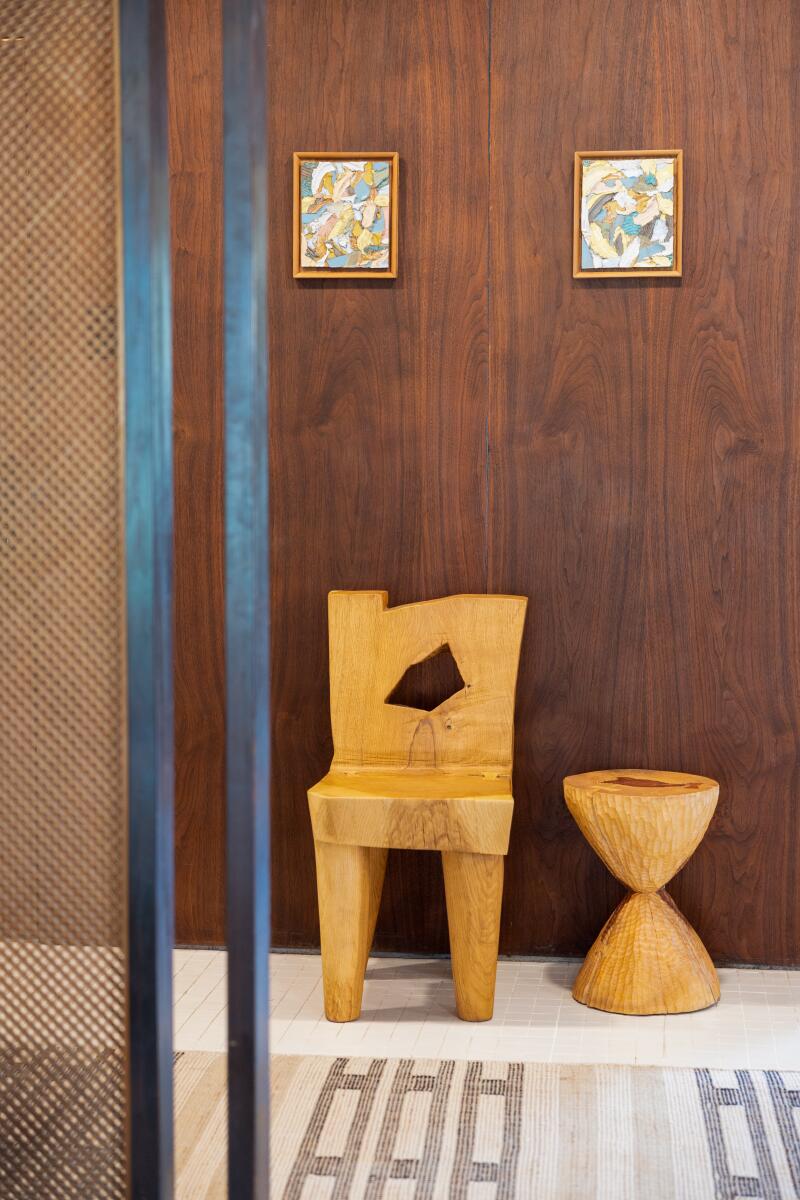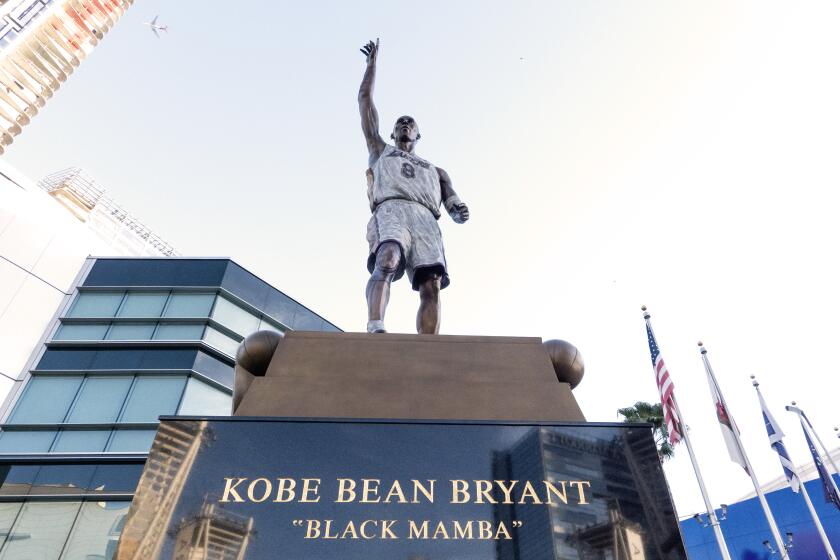
Walking through the garden of designer and sculptor Vince Skelly’s Claremont home is a distinct local sensory experience. Following a decade living in Portland, Ore., “I just want it to feel like Southern California,” he says as he grazes a palm over a salvia plant, releasing its aroma. Since returning in 2021, the self-taught artist has been expanding his practice and nurturing a connection to his hometown, colloquially dubbed “the City of Trees and PhDs.”
Skelly’s foray into wood sculpting began in 2017, when after spending his days tied to a screen as a graphic designer he’d fire up power tools in his Portland garage. He began by exploring “the limitations of what I can lift into my car, and [using] one chainsaw and tools. Those led to the vocabulary of forms I’m known for.”
Learning about legendary woodworkers such as George Nakashima and JB Blunk in particular, featured in the 2010 book “Handcrafted Modern,” was revelatory. “I was surprised he did all that with a chainsaw because his sculptures felt so refined — these abstract forms out of redwood and cypress,” Skelly says of Blunk. “A chainsaw is such an aggressive tool, and using it in a thoughtful, considered way to create form and shape intrigued me.” Then scaling down to using other analog devices yields nuance and detail.

Furniture made by Vince Skelly, with clay paintings by Dino Matt above.

Artwork made by Vince Skelly.

Within a few short years, he was brainstorming ideas and taking commissions from Off-White brand founder and LVMH menswear artistic director Virgil Abloh via DM. The largest prototype project wasn’t fully realized as planned before Abloh’s death in November 2021, but these exchanges “made me realize it’s great to dream big and take chances.” Skelly’s goods being recently installed in the Burberry store on Rodeo Drive is another sign the fashion world appreciates his point of view.
After managing grief, anxiety and depression, video game designer Ana Cho turned to pottery and woodworking to sustain her.
Some details shift, but the core challenge remains: namely, how to take raw timber and apply “the least amount of modification to turn it into a finished piece.”
Benches, chairs, stools, tables and sculptures straddle functional and decorative purposes. Unstained and waxed logs retain their intrinsic qualities yet are transformed in ways that honor their origins. Smooth bench surfaces sit atop hulky rounded bases, and smaller tactile sculptures result from Skelly’s reductive process. Human intervention is evident yet humbled by a certain primal resonance.
Like his heroes’ output, no two pieces are identical. What he describes as “an index,” however, has evolved for clients who want sculptural furniture that retains nature’s imperfections and quirks — but not flop-on-the-sofa comfort. For much of his work Skelly sources specific lumber with the end product in mind, knowing that each undertaking will still take on its own character.
Minimizing waste is a key precept. “I have a hard time throwing away scraps,” he says with a laugh about the shards and wedges that litter the edges of his backyard and the floor of his nearby studio in La Verne. He repurposes offcuts into smaller experiments, including rhythmic, polychromatic wall-mounted pieces hanging in his own home; one is above the white oak fireplace mantle he hand-chiseled.
“Using found wood to dictate new forms” remains a generative exercise, especially when preparing for shows with curator and gallerist Alex Tieghi-Walker of Tiwa Select, who organized “After the Storm” in L.A. in 2022, which showcased pieces made from salvageable debris in the wake of that year’s windstorm. What Skelly will present with Tiwa Select later this year in New York City doesn’t have an “end client, so I can just do whatever I want,” he explains.


The sensitively updated home where he lives with his wife, Jessica, and their infant son is a laboratory for living with these objects. So far, the presence of a crawling baby has led to only minimal adjustments and aesthetic intrusions.
Rather than function as austere showpieces, Skelly’s creations blend into this welcoming home environment full of earthy colors and personal treasures, which include a beloved rocking chair inspired by Claremont-adjacent master craftsman Sam Maloof that Jessica’s father crafted in the 1970s. It’s an ideal companion piece to the site-specific daybed Skelly made to best enjoy the view from the sunroom’s expansive windows, where dappled light filters through an outdoor screen of towering bamboo.
Looking for an Eames lounge chair or a Danish modern credenza? Here’s a list of the 18 best places to shop for Midcentury Modern furniture in L.A.
The Skellys are proud stewards of the midcentury property that holds a convergence of Claremont heritage. While waiting for the right house to come around to plot their move back, they were thrilled to hear about the modest two-bedroom home of former California Botanic Garden director, author and professor Lee Lenz. In the late 1950s, the accomplished botanist and conservationist became the second owner of a spec house for an unrealized cul-de-sac development of concrete masonry residences.
Lenz lived in the property situated within view of his workplace until his death in 2019 at the age of 104. Over the decades, this corner lot became a site for the scientist to apply his expertise, establishing a fantastical, idiosyncratic sanctuary populated with extensive plantings. It’s also a stone’s throw from the studio of seminal mosaic artist and architectural designer Millard Sheets (now home to Claremont Eye Associates).
Given Claremont’s tightknit community, Skelly surmises Lenz and Sheets knew each other. The turquoise mosaic tiles that clad concrete pads in the yard, for instance, perhaps came as surplus from Sheets’ workshop. The inspiration felt immediate.
“It’s a visual city [with] a lot of art. We left our back door and we were in the campuses, climbing on sculptures and seeing Millard Sheets’ mosaics,” Skelly recalls. “I grew up going to the [California Botanic] Garden — then fast-forward to this house.”

Detail of a wood mosaic outdoor shower made by Vince Skelly.

Detail of backyard native plants and outdoor artwork made by Vince Skelly.

Reimagining the backyard in collaboration with David Godshall of noted landscape design firm Terremoto simultaneously pays homage to Lenz and reflects a vision for this young family. California native plants, hardscape additions and meandering paths provide a perfect backdrop for Skelly’s exterior works.
Skelly disassembled Lenz’s old-growth redwood bird cages and repurposed them into a deck. He also installed an original “wood mosaic”-adorned outdoor shower — a sly reference to Sheets. Plenty more remnants remain for potential future use.
Here are the best retail native plant nurseries in Southern California to help you create a habitat for birds and pollinators in your yard or even on a patio.
His personal and professional life are inexorably tied to the town where Skelly’s artist parents originally moved to attend school at Claremont Graduate University. He’s eager to make his mark through a public art commission that involves producing a bench from another casualty of the 2022 windstorm, and to develop more found-material carved sculptural seating with students as part of a pilot program at Pomona College.
“We know how special it is because of people like Millard Sheets and Sam Maloof who left their fingerprints on the public art scene and the architecture,” he reflects of Claremont. Being outside of L.A. proper has other advantages too. “It’s more accessible to do the things you want to do in a small town.”
More to Read
Sign up for our L.A. Times Plants newsletter
At the start of each month, get a roundup of upcoming plant-related activities and events in Southern California, along with links to tips and articles you may have missed.
You may occasionally receive promotional content from the Los Angeles Times.











